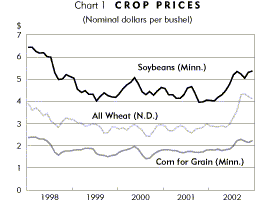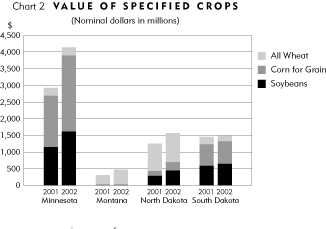Reduced supply and increased demand have pushed recent prices of corn, soybeans and wheat to five-year highs. The significant price increases on these major district crops (see Chart 1) are having a diverse impact on a variety of industries. Winners are the lucky producers blessed with high yields and high prices, bankers, landowners, U.S. taxpayers and crop input suppliers. Losers are those paying the higher prices, including ethanol, livestock and dairy producers.

Source: U.S. Department of Agriculture
Supply
Why have prices gone up? The answer relates back to supply and demand. On the supply side of production, U.S. output of corn, soybeans and wheat fell last year as a result of devastating drought across major portions of the United States. In addition, worldwide production fell for corn and wheat.
According to the U.S. Department of Agriculture (USDA), 2002-2003 worldwide output of wheat and corn is projected to decrease from 2001-2002 by 2.1 percent (to 567 million metric tons) and 1 percent (to 593 million metric tons), respectively, largely due to reductions in U.S. production. Corn output estimates reflect increased production in the rest of the world.
Worldwide production of soybeans, however, is projected to increase by 4.7 percent to nearly 193 million metric tons. Soybean production figures would be even higher were it not for an anticipated reduction in U.S. output.
Demand
Worldwide consumption of soybeans and wheat is projected to increase in 2002-2003, while corn is expected to remain flat. The USDA estimates that 2002-2003 wheat consumption will increase from 2001-2002 by 1.9 percent to 595 million metric tons, due mainly to increased imports from Russia and Ukraine. And soybean consumption is projected to increase by 5.4 percent to about 194 million metric tons. While both crops will see greater consumption, the figures are tempered by a reduction in U.S. consumption.
Winners
There are several beneficiaries of higher prices, including many crop farmers in the eastern Dakotas, Minnesota and western Wisconsin who had huge harvests. This swath of the district enjoyed almost ideal growing conditions, large yields and high prices in 2002. Minnesota had a record corn crop-over 1 billion bushels. Higher prices and volumes generated increased farm revenues, more than offsetting rising costs (see Chart 2).

Source: U.S. Department of Agriculture
Producers were not the only ones who profited from higher prices. Bankers and landowners in these areas also benefited. Agricultural bankers in Minnesota responding to the fourth-quarter 2002 survey of agricultural lenders reported higher loan repayments and fewer loan extensions. In addition, higher crop revenues have affected land prices. As more farm profits are generated, landowners can charge higher prices for renting land. "Real estate values in some areas continue to rise due to good crop yields, lower interest rates and expanding well-capitalized operations," wrote a banker from eastern South Dakota. According to the survey, farmland prices increased the most in Minnesota.*
U.S. taxpayers also indirectly benefited from higher prices as lower subsidy payments went to farmers: The Commodity Credit Corp. paid out $12.4 billion in fiscal year 2002, compared with $22 billion in fiscal year 2001.
Losers
Not everybody benefited from the higher prices. Farmers in Montana and the western Dakotas faced drought conditions and severely reduced yields, which more than offset higher prices. To cushion farmers' economic distress, federal government emergency loans were available.
In addition, higher input costs affected producers' profits. But while ranchers paid higher feed costs and reduced herds, they received higher prices for their meat. In contrast, dairy producers, who also paid more for their feed, saw lower milk and cheese prices. Furthermore, ethanol producers faced higher input costs.
Outlook
In response to higher prices, producers are rolling the dice and are hoping to win big by increasing plantings. The USDA expects U.S. production of corn, wheat and soybeans to increase 14 percent, 6 percent and 3 percent, respectively, in 2003 compared with 2002 harvests. As a result, seed and farm implement producers are likely to report sales increases this year.
Meanwhile, seedings of winter wheat in the United States are up 6 percent from the 2002 crop year. Plantings in the drought areas of the Ninth Federal Reserve District are up significantly. The number of acres planted with winter wheat was up 21 percent in Montana and 15 percent in South Dakota from the 2002 crop year. Unfortunately, district producers may lose out. Less than average snow cover this past winter has had a twofold effect on the winter wheat crop—low moisture and a lack of protection against cold and wind erosion.
The USDA forecasts that prices will drop primarily due to expected increases in future harvests. And many farmers may realize those price decreases—only about 10 percent of the 2001 corn and soybean crops were locked into prices through futures contracts.
*See detailed results
of the fourth-quarter agricultural credit conditions survey.





